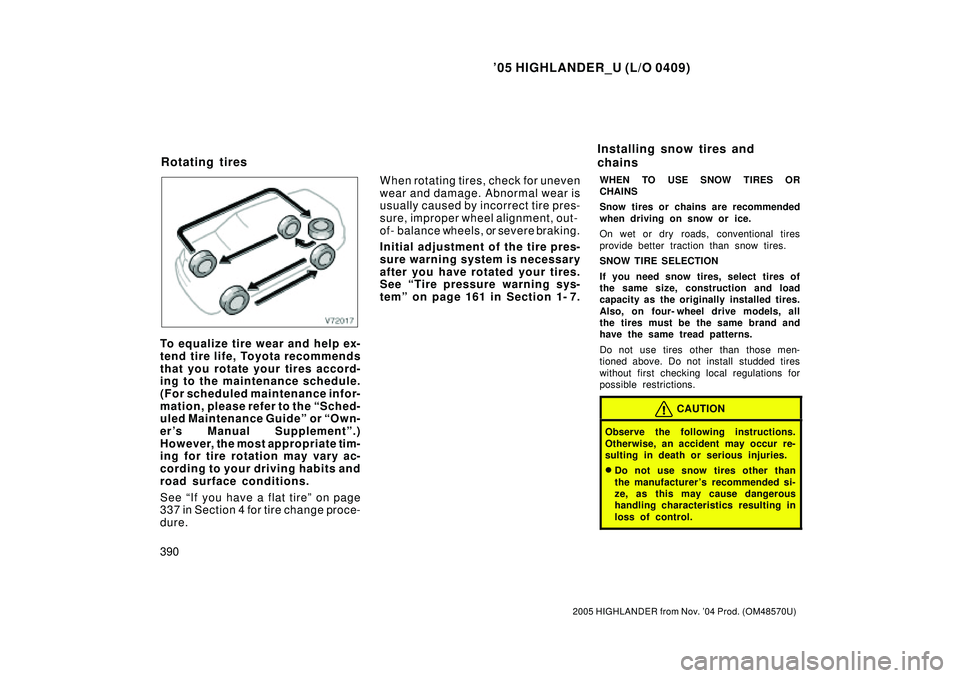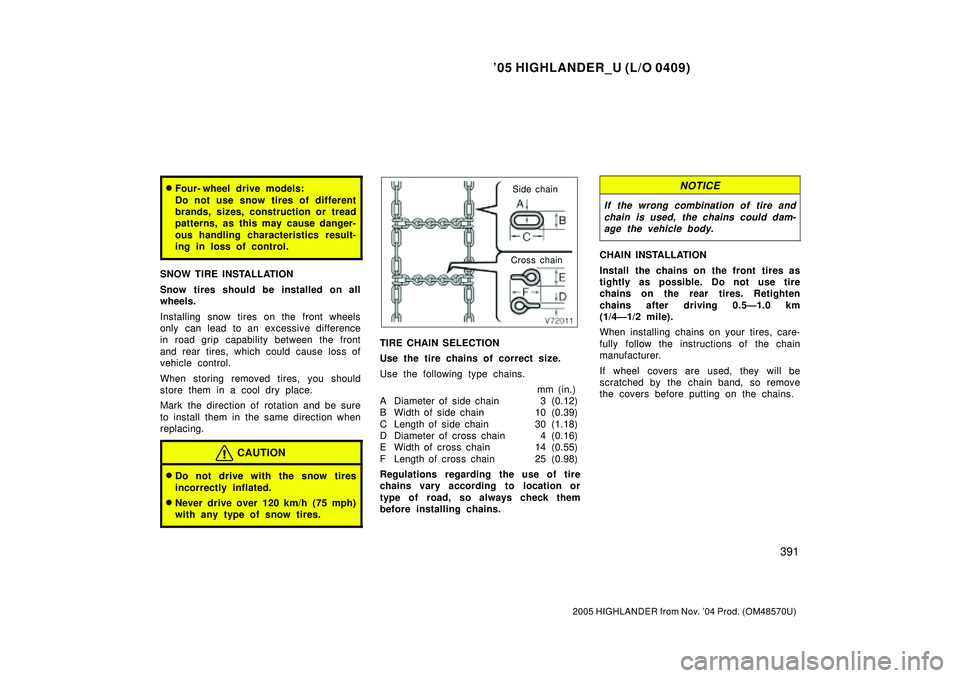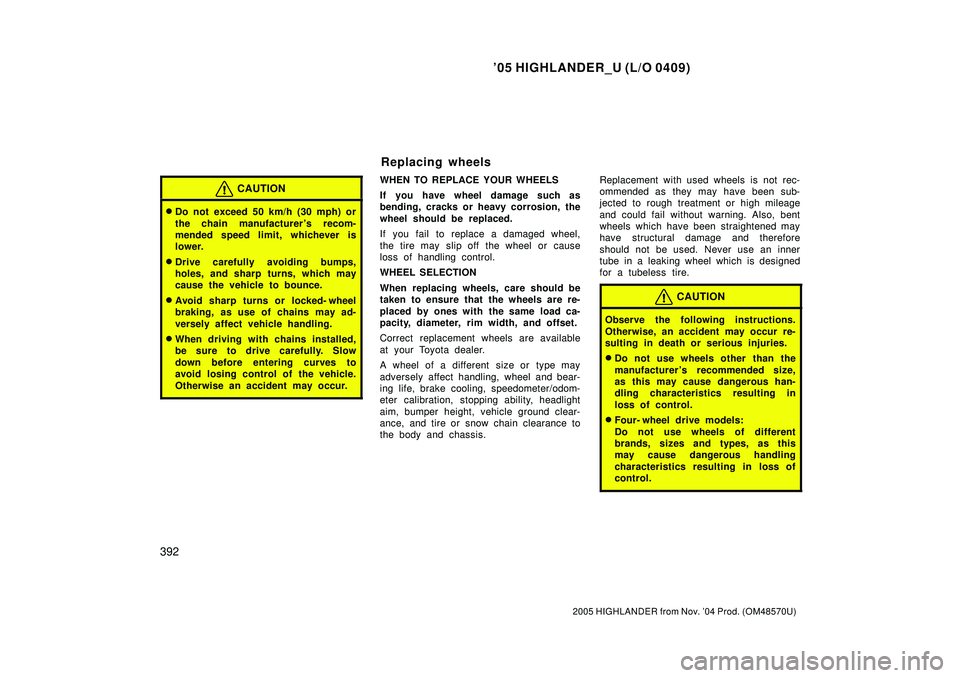Page 692 of 2572

'05 HIGHLANDER_U (L/O 0409)
390
2005 HIGHLANDER from Nov. '04 Prod. (OM48570U)
To equalize tire wear and help ex-
tend tire life, Toyota recommends
that you rotate your tires accord-
ing to the maintenance schedule.
(For scheduled maintenance infor-
mation, please refer to the Sched-
uled Maintenance Guideº or Own-
er's Manual Supplementº.)
However, the most appropriate tim-
ing for tire rotation may vary ac-
cording to your driving habits and
road surface conditions.
See If you have a flat tireº on page
337 in Section 4 for tire change proce-
dure.When rotating tires, check for uneven
wear and damage. Abnormal wear is
usually caused by incorrect tire pres-
sure, improper wheel alignment, out-
of- balance wheels, or severe braking.
Initial adjustment of the tire pres-
sure warning system is necessary
after you have rotated your tires.
See Tire pressure warning sys-
temº on page 161 in Section 1- 7.
WHEN TO USE SNOW TIRES OR
CHAINS
Snow tires or chains are recommended
when driving on snow or ice.
On wet or dry roads, conventional tires
provide better traction than snow tires.
SNOW TIRE SELECTION
If you need snow tires, select tires of
the same size, construction and load
capacity as the originally installed tires.
Also, on four- wheel drive models, all
the tires must be the same brand and
have the same tread patterns.
Do not use tires other than those men-
tioned above. Do not install studded tires
without first checking local regulations for
possible restrictions.
CAUTION
Observe the following instructions.
Otherwise, an accident may occur re-
sulting in death or serious injuries.
�Do not use snow tires other than
the manufacturer 's recommended si-
ze, as this may cause dangerous
handling characteristics resulting in
loss of control.
Rotating tiresInstalling snow tires and
chains
Page 693 of 2572

'05 HIGHLANDER_U (L/O 0409)
391
2005 HIGHLANDER from Nov. '04 Prod. (OM48570U)
�Four- wheel drive models:
Do not use snow tires of different
brands, sizes, construction or tread
patterns, as this may cause danger-
ous handling characteristics result-
ing in loss of control.
SNOW TIRE INSTALLATION
Snow tires should be installed on all
wheels.
Installing snow tires on the front wheels
only can lead to an excessive difference
in road grip capability between the front
and rear tires, which could cause loss of
vehicle control.
When storing removed tires, you should
store them in a cool dry place.
Mark the direction of rotation and be sure
to install them in the same direction when
replacing.
CAUTION
�Do not drive with the snow tires
incorrectly inflated.
�Never drive over 120 km/h (75 mph)
with any type of snow tires.
Side chain
Cross chain
TIRE CHAIN SELECTION
Use the tire chains of correct size.
Use the following type chains.
mm (in.)
A Diameter of side chain 3 (0.12)
B Width of side chain 10 (0.39)
C Length of side chain 30 (1.18)
D Diameter of cross chain 4 (0.16)
E Width of cross chain 14 (0.55)
F Length of cross chain 25 (0.98)
Regulations regarding the use of tire
chains vary according to location or
type of road, so always check them
before installing chains.
NOTICE
If the wrong combination of tire and
chain is used, the chains could dam-
age the vehicle body.
CHAIN INSTALLATION
Install the chains on the front tires as
tightly as possible. Do not use tire
chains on the rear tires. Retighten
chains after driving 0.5Ð1.0 km
(1/4Ð1/2 mile).
When installing chains on your tires, care-
fully follow the instructions of the chain
manufacturer.
If wheel covers are used, they will be
scratched by the chain band, so remove
the covers before putting on the chains.
Page 694 of 2572

'05 HIGHLANDER_U (L/O 0409)
392
2005 HIGHLANDER from Nov. '04 Prod. (OM48570U)
CAUTION
�Do not exceed 50 km/h (30 mph) or
the chain manufacturer 's recom-
mended speed limit, whichever is
lower.
�Drive carefully avoiding bumps,
holes, and sharp turns, which may
cause the vehicle to bounce.
�Avoid sharp turns or locked- wheel
braking, as use of chains may ad-
versely affect vehicle handling.
�When driving with chains installed,
be sure to drive carefully. Slow
down before entering curves to
avoid losing control of the vehicle.
Otherwise an accident may occur.
WHEN TO REPLACE YOUR WHEELS
If you have wheel damage such as
bending, cracks or heavy corrosion, the
wheel should be replaced.
If you fail to replace a damaged wheel,
the tire may slip off the wheel or cause
loss of handling control.
WHEEL SELECTION
When replacing wheels, care should be
taken to ensure that the wheels are re-
placed by ones with the same load ca-
pacity, diameter, rim width, and offset.
Correct replacement wheels are available
at your Toyota dealer.
A wheel of a different size or type may
adversely affect handling, wheel and bear-
ing life, brake cooling, speedometer/odom-
eter calibration, stopping ability, headlight
aim, bumper height, vehicle ground clear-
ance, and tire or snow chain clearance to
the body and chassis.Replacement with used wheels is not rec-
ommended as they may have been sub-
jected to rough treatment or high mileage
and could fail without warning. Also, bent
wheels which have been straightened may
have structural damage and therefore
should not be used. Never use an inner
tube in a leaking wheel which is designed
for a tubeless tire.
CAUTION
Observe the following instructions.
Otherwise, an accident may occur re-
sulting in death or serious injuries.
�Do not use wheels other than the
manufacturer 's recommended size,
as this may cause dangerous han-
dling characteristics resulting in
loss of control.
�Four- wheel drive models:
Do not use wheels of different
brands, sizes and types, as this
may cause dangerous handling
characteristics resulting in loss of
control.
Replacing wheels
Page 2042 of 2572
I38147
I38148
- DIAGNOSTICSNAVIGATION SYSTEM
05-1777
1967 Author�: Date�:
2005 HIGHLANDER REPAIR MANUAL (RM1144U)
(9) When the vehicle runs on the snowy road or a
mountain path with the chains installed or using a
spare tire, the current vehicle position mark may
deviate from the correct position.
(10) When a tire is changed, the current vehicle position
mark may deviate from the correct position.
HINT:
�Diameter of the tire may change, causing a speed sensor
error.
�Performing the ºtire changeº in calibration mode will allow
the system to correct the current vehicle position faster.
Page 2354 of 2572

05CL9-03
F46769
Tire Pressure
Warning Lamp
- DIAGNOSTICSTIRE PRESSURE WARNING SYSTEM
05-729
919 Author�: Date�:
2005 HIGHLANDER REPAIR MANUAL (RM1144U)
TIRE PRESSURE WARNING SYSTEM
PRECAUTION
1. TIRE PRESSURE WARNING SYSTEM PRECAUTION
(a) When the tire pressure warning lamp comes on, immedi-
ately check the air pressure of all tires and adjust to the
specified pressure.
Specified Value
Front210 kpa (2.1 kgf/cm2, 30 psi)
Rear210 kpa (2.1 kgf/cm2, 30 psi)
(b) This system requires initializing after changing tires or
wheels, or after rotating the tires (see page 28-1).
Set tire pressure within the specified range before initializ-
ing. If the tire air pressure is not within the specified range,
the tire pressure warning system will not function.
(c) In the following cases, the system may not operate nor-
mally.
�A compact spare tire, snow tires, or tire chains are
used.
�The tire pressure is excessively higher than speci-
fied, or tire pressure suddenly drops due to bursting
or other causes.
�The vehicle is driven on a slippery road surface
such as rough or frozen roads.
�The vehicle speed is 19 mph (30 km/h) or less or
more than 62 mph (100 km/h) , and the driving dura-
tion is less than 5 minutes.
�The tires differ in tread pattern or manufacture.
�The tires are not the specified size.
�The tread wear is very different among the installed
tires.
�Rapid acceleration/deceleration or sharp turns is
continued.
�Towing a trailer.
�The loading is over the limit or imbalanced.
�Initialization was not performed correctly after re-
placing or rotating tires or wheels.
�The outside temperature is below 32�F (0�C) or
above 104�F (40�C).